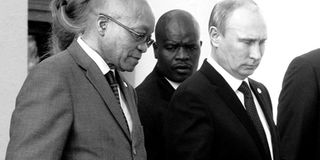Brics group set to launch its own bank

PHOTO | AFP | FILE South African President Jacob Zuma (left) and Russia’s President Vladimir Putin after a Brics leaders’ meeting at the G20 summit on September 5, 2013 in Saint Petersburg, Russia.
What you need to know:
- Nations have potential to create ‘new economic and international political order’
- Fresh from the World Cup final, Brazilian President Dilma Rousseff hosts the leaders of Russia, India, China and South Africa in Fortaleza on Tuesday before an unprecedented meeting with South American leaders the next day in Brasilia.
- The talks in Fortaleza will open a series of marathon summits and bilateral meetings that will bring the Brics group to Latin America.
BRASILIA, Brazil, Saturday
The Brics group of emerging powers will launch its own development bank at a summit next week, using its growing influence to establish a counterweight to Western-dominated financial organisations.
Fresh from the World Cup final, Brazilian President Dilma Rousseff hosts the leaders of Russia, India, China and South Africa in Fortaleza on Tuesday before an unprecedented meeting with South American leaders the next day in Brasilia.
On the diplomatic front, the summit will mark the first face-to-face meeting between India’s new Hindu nationalist Prime Minister Narendra Modi with Chinese President Xi Jiping.
For Russian President Vladimir Putin, who travelled to Cuba this week, the trip comes amid newly frayed relations with the West over the crisis in Ukraine.
The leaders, including South African President Jacob Zuma, will establish two new financial organisations: a development bank to fund infrastructure projects and a reserve fund to fend off currency and balance of payments crises.
The Brics are “countries with enormous potential that can gain many benefits for themselves but also for a new economic and international political order,” said senior Brazilian Foreign Ministry official Jose Alfredo Graca Lima.
Graca Lima said the bank and the reserve would “complement” the Washington-based World Bank and International Monetary Fund.
The bank will have capital of $50 billion with each country contributing $10 billion, while the reserve, which has been described as a “mini-IMF,” will have $100 billion at its disposal, Graca Lima told reporters.
LARGEST CONTRIBUTOR
For the fund, China will make the biggest contribution, $41 billion, followed by $18 billion from Brazil, India and Russia and $5 billion from South Africa.
“The Brics want to create alternatives, a type of global monetary policy more in tune with the realities of emerging countries,” Andre Perfeito, chief economist at Gradual Investimentos consultancy, told AFP.
Despite their agreement on the need for a bank, the five countries are split on where it should be headquartered.
Graca Lima said Shanghai was the frontrunner to host the bank but South Africa’s Trade and Industry Minister Rob Davies said Johannesburg was still in the running. New Delhi and Moscow are the other candidates.
The five nations are also negotiating who should hold the bank’s rotating presidency first. And the membership of the board of directors has yet to be decided.
The Brics were created after economist Jim O’Neill used the acronym in 2001 to describe the growing powers. They are now seeking to break the European, US and Japanese domination of financial institutions.
“The Brics unite a group of nations with different, even opposed, interests,” said Oliver Stuenkel, author of Brics and the Future of Global Order and professor at the Getulio Vargas Foundation.
But they have given developing nations the ability to use a “platform” strong enough to challenge world order, he said.
The talks in Fortaleza will open a series of marathon summits and bilateral meetings that will bring the Brics group to Latin America.





